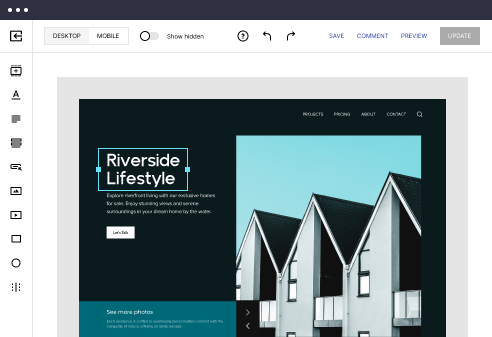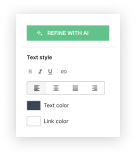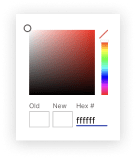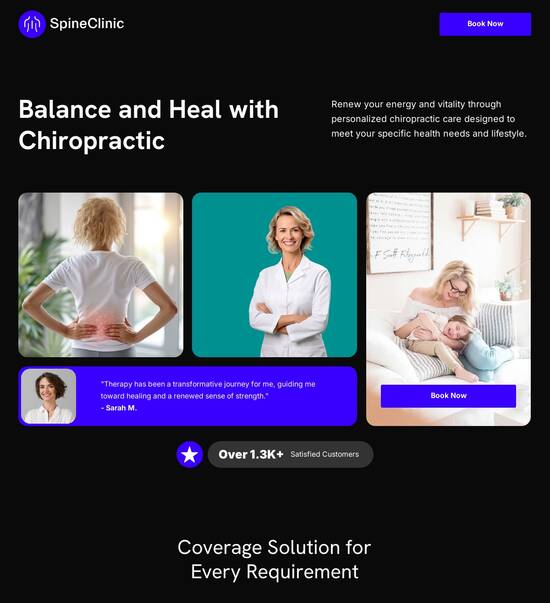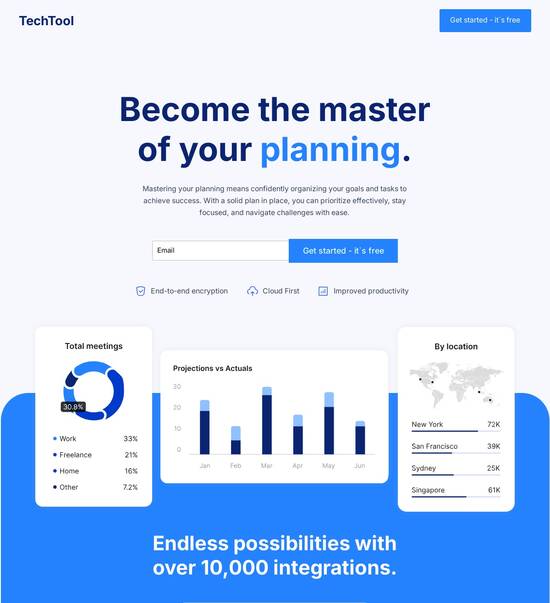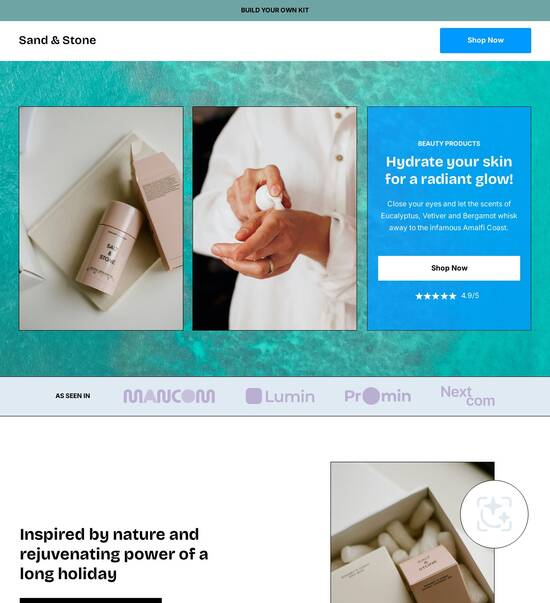
HTML/CSS optimized case study page template
Explore Similar TemplatesAbout template
Supercharge your case study page with HTML/CSS for outstanding performance! Learn more today.
Recommended templates
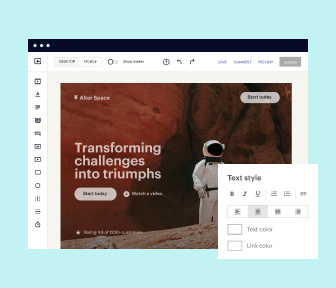
Easy to build without coding
With the intuitive drag-and-drop builder, anyone on your team can create high-converting pages without any knowledge of code or design. Make enhancements to your landing page with custom widgets using Javascript, HTML/CSS, or third-party scripts.
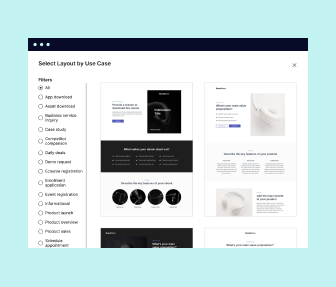
Multiple layouts for any industry and goal
Select from 500+ landing page layouts built to boost conversions across industry-specific scenarios. Customize them by adjusting fonts, adding images, and generating on-brand content with the AI assistant. Quickly scale with Instablocks® and Global Blocks that you can save, reuse, and update globally.
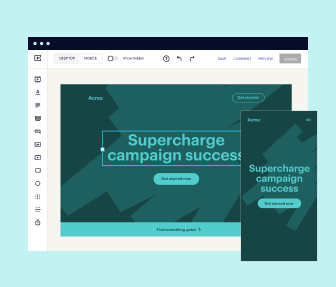
Loads fast and looks polished on any device
Every template is responsive, which means they present professionally on any device and load blazingly fast with our Thor Render Engine. You can also power them up with Google AMP technology to deliver an unparalleled mobile experience and drive higher conversions.
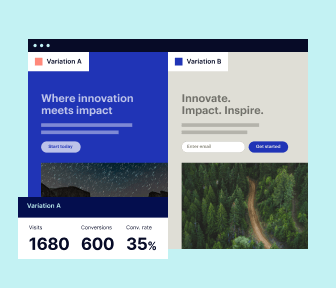
Robust analytics & experimentation
Get real-time updates and reporting across all your devices, showing the number of visitors, conversions, cost-per-visitor, and cost-per-lead. Launch AI-powered experiments, run A/B tests, and use heatmaps to analyze user behavior, then optimize your landing page to maximize conversions.

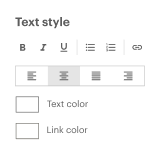
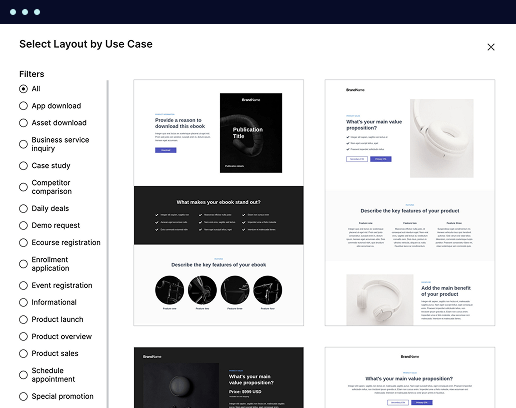
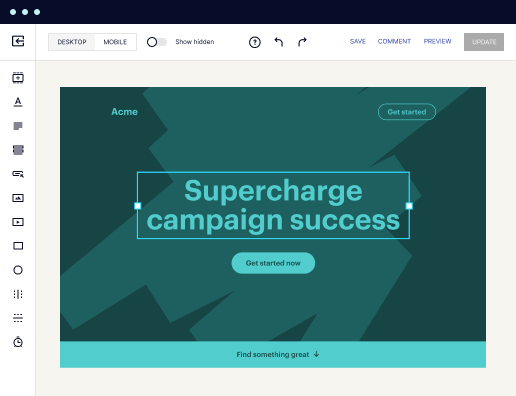
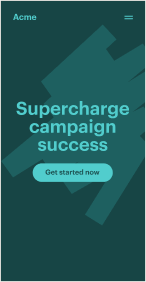
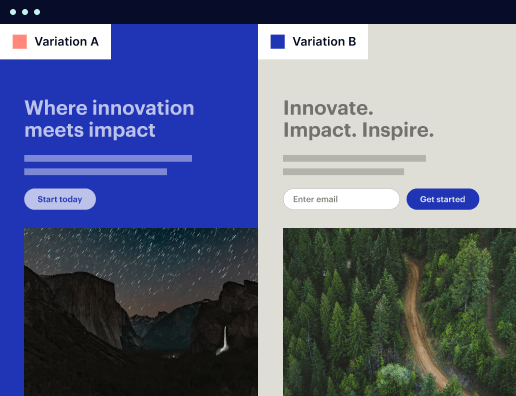

Easy to build without coding
With the intuitive drag-and-drop builder, anyone on your team can create high-converting pages without any knowledge of code or design. Make enhancements to your landing page with custom widgets using Javascript, HTML/CSS, or third-party scripts.
Multiple layouts for any industry and goal
Select from 500+ landing page layouts built to boost conversions across industry-specific scenarios. Customize them by adjusting fonts, adding images, and generating on-brand content with the AI assistant. Quickly scale with Instablocks® and Global Blocks that you can save, reuse, and update globally.
Loads fast and looks polished on any device
Every template is responsive, which means they present professionally on any device and load blazingly fast with our Thor Render Engine.
Robust analytics & experimentation
Get real-time updates and reporting across all your devices, showing the number of visitors, conversions, cost-per-visitor, and cost-per-lead. Launch AI-powered experiments, run A/B tests, and use heatmaps to analyze user behavior, then optimize your landing page to maximize conversions.
All the features you need to build css designsample com
Explore more featuresLearn how to build web development agency case study template
Frequently asked questions about case study html template
Leading the way in building high-performing landing pages





Study template html css: Your ultimate how-to guide
Instapage is designed as the ultimate landing page and conversion rate optimization (CRO) platform, tailored for marketers striving to enhance their digital campaign effectiveness. This guide will provide you with step-by-step instructions on how to leverage Instapage's features, from template selection to optimization techniques, ensuring your campaigns are not only visually appealing but also effective in converting visitors into leads.
Choosing the Right Template for Your Campaign
The first step in creating a high-converting landing page is selecting an appropriate template. Instapage offers 100+ professionally crafted templates that cater to various industries and purposes. Choose a template that aligns with your campaign's goals to ensure optimal engagement.
- Business Services: Templates designed for service-oriented industries that emphasize trust and functionality.
- Education: Options that highlight enrollment and course details attract student demographics.
- Tech/SaaS: Modern, sleek layouts focusing on product features or demos that resonate with tech-savvy audiences.
Utilizing Lead Generation Elements
After your template is selected, integrate lead generation elements to capture visitor information effectively. Instapage provides pre-built forms and call-to-action buttons that can be customized easily.
- Customizable Forms: Tailor fields to gather specific information from your audience, enhancing lead quality.
- High-Visibility CTAs: Use contrasting colors and strategic placements to draw attention.
- Lead Magnet Integration: Offer downloadable content, such as eBooks or whitepapers, in exchange for contact details.
Optimizing for Higher Conversion Rates
Optimization is the cornerstone of successful landing pages. Utilize Instapage's built-in analytics and A/B testing features to understand visitor behavior and adjust accordingly.
- Heatmaps: Gain insights into user interactions to tweak layouts and improve engagement.
- A/B Testing: Test different headlines, images, and call-to-action placements to identify the most effective versions.
- Performance Metrics: Regularly review data to assess what's working and areas needing improvement.
By following these steps, you can create landing pages that not only attract visitors but convert them into loyal customers.
Instapage’s powerful features help marketers optimize their campaigns regardless of team size or budget, ensuring every dollar spent on marketing is maximized for ROI.
Ready to take your landing pages to the next level? Start using Instapage today and watch your conversion rates soar!
HTML/CSS optimized case study page template: a comprehensive guide
Understanding the significance of an HTML/CSS optimized case study page template
Case studies play a crucial role in digital marketing by providing anecdotal evidence of success to potential clients. They enhance credibility and trust as they showcase how a product or service effectively solved a problem for a real customer. This narrative-driven approach not only paints a picture of what success looks like but also drives conversion rates by guiding prospects through their decision-making journey. By illustrating real-world results, case studies serve as compelling testimonials that can significantly impact a company's bottom line.
Optimizing these case study pages is vital for several reasons. First, page load speed affects user engagement; a slow-loading page can lead to high bounce rates. Furthermore, with the growing prevalence of mobile browsing, having a fully responsive design ensures content is accessible and user-friendly across various devices. Improving user experience through intuitive design not only keeps visitors on the page longer but also encourages interaction, whereas effective SEO practices improve visibility in search engine results, driving organic traffic.
Key features of HTML/CSS optimized case study page templates
A flexible and modular design is essential when creating HTML/CSS optimized case study page templates. Such designs provide numerous components that allow for easy customization, ensuring that marketers can tailor the appearance and functionality of their case studies to their specific branding and targeted audience. Utilizing grids and frameworks like Bootstrap can streamline the development process, promoting a cohesive look across various elements while allowing for unique enhancements related to specific case studies.
Additionally, responsive layouts that utilize media queries play a significant role in optimization. These layouts ensure that case studies are visually appealing on all device types, maintaining usability whether on a desktop or mobile phone. Enhancing aesthetics with well-crafted CSS further elevates the visitor's experience, incorporating smooth animations and thoughtful typography to communicate the message effectively. Thoughtful color schemes can also enhance the message, allowing the storyline of the case study to unfold visually.
Integrating best practices within the template
Adopting a semantic HTML structure within case study templates cannot be overstated. This structure not only promotes accessibility but also guides search engines in understanding the context of the content better. Elements like headings and lists must be strategically utilized to provide a clear narrative flow, thereby improving the overall readability. In addition, semantic tags such as , , and can significantly enhance the template's crawlability, making it easier for search engines to index the page.
Another best practice is integrating CSS preprocessors like SASS or LESS. These tools help in streamlining stylesheets, allowing developers to write more maintainable and scalable code. By utilizing variables, nested rules, and mixins, developers can save time during updates and ensure a consistent design across different case studies. This level of maintainability is crucial, especially for teams that expect to iterate quickly on templates as they gather insights from user feedback.
The functionality of document.addEventListener
Understanding event handling in web development is integral to creating interactive and engaging case study pages. The document.addEventListener method allows developers to respond to user actions effectively, enhancing the overall interactivity of the webpage. This functionality can be employed to create dynamic case study interactions that maintain user engagement, such as implementing event listeners for clickable tabs that switch between different case studies or hover effects that reveal detailed insights when users hover over specific elements.
Efficient event listeners are crucial for performance, as poorly implemented listeners can lead to excessive resource consumption and slow down the site's performance. By leveraging event delegation, developers can listen to events for multiple elements through a single event listener, minimizing memory leaks and maximizing responsiveness.
The importance of DOMContentLoaded event
The DOMContentLoaded event is crucial in web optimization, particularly for ensuring content is fully loaded before enabling user interactivity. By listening for this event, developers can implement scripts that enhance user experience through instant feedback mechanisms. For instance, a properly timed initialization of interactive components based on this event can eliminate frustrations that arise from unresponsive features, thereby improving the overall user journey.
Practical implementation examples include sequential loading of case study components, which might involve displaying one case study at a time while others load in the background. This method not only speeds up perceived load time but also creates a more fluid experience for the user. Best practices for leveraging DOMContentLoaded include avoiding UI blocking and ensuring compatibility across various browsers, thus making your case study templates accessible to a broader audience.
Case study visual design elements
Crafting engaging visual case studies is vital for capturing visitor interest and effectively conveying information. Utilizing images and infographics can break up text-heavy sections and offer a visual representation of data and achievements, making the content more digestible. Furthermore, interactive charts and graphs can illustrate quantitative results from case studies, providing a compelling visual narrative that supports the written content.
Design choices significantly impact user perception, with color theory playing a broad role in persuasion. Using colors strategically can invoke specific emotions and guide prospective clients through the content. Additionally, implementing a layout hierarchy can aid in improving readability by guiding users through the most important elements first, thereby ensuring that the key messages are communicated effectively.
Performance optimization techniques
Minifying HTML and CSS is an essential performance optimization technique that reduces file sizes, consequently speeding up load times. Tools like HTMLMinifier and CSSNano can automate this process, enabling marketers to create leaner pages without unnecessary code bloat. Reduced load times not only enhance user experience but also improve SEO rankings, making this technique a fundamental practice in creating optimized case studies.
Another key technique is implementing lazy loading for images and content. This strategy enhances initial load speed by deferring the loading of non-essential resources until they are needed. As users scroll down the page, images and other content load only when within view, which significantly saves bandwidth while improving user experience during long scrolls. Finally, monitoring and analyzing performance metrics using real user monitoring tools can yield insights into user engagement, informing continual improvements to the site.
Future trends in case study page design
As technology evolves, the design of case study pages is also adapting. The emergence of AI in web design opens avenues for personalized case studies that cater to individual user preferences. With automated optimization techniques powered by machine learning, marketers can easily analyze user behavior and make real-time adjustments to improve engagement and conversion rates.
Additionally, incorporating virtual and augmented reality for interactive case studies is on the horizon. These immersive experiences can provide users with a more profound understanding of the case studies being presented, revolutionizing how success stories are delivered. Proactive user engagement through features like chatbots can further enrich case studies, ensuring visitors receive immediate responses to inquiries and enhancing their overall experience.
Practical examples of innovative case study templates
Analyzing successful implementations of case study templates across various industries can provide invaluable insights. For instance, the tech industry often uses concise visual storytelling combined with robust performance data, while marketing and advertising sectors focus heavily on emotional storytelling that resonates with prospective clients. These tailored approaches highlight how case studies can significantly differ with their target audience in mind and the significance of data-driven results in convincing visitors.
Lessons learned from high-performing templates can inform optimal design choices and content strategies. Key takeaways from these implementations include emphasizing clear calls to action, maintaining visual consistency, and ensuring high-quality data presentation. Overall, these insights can guide marketers in creating their own optimized case study pages, enhancing both effectiveness and usability.
Final thoughts on creating optimal case study pages
Creating optimal case study pages requires fostering a culture of continuous improvement. Regularly gathering user feedback is paramount for iteration, allowing marketers to refine templates and adapt to user preferences. Monitoring competitor approaches can offer benchmarking opportunities, ensuring your case studies don’t just keep pace but proactively set trends in the industry.
Ultimately, the responsibility lies with marketers to invest in optimizing their case study templates. By marrying insightful design with robust analytics and performance practices, businesses can build a suite of case studies that not only showcase success but also actively drive conversions and trust amongst their client base.
Ready to skyrocket conversions?
Supercharge your ad campaigns with high-performing landing pages
Get started